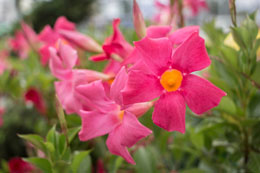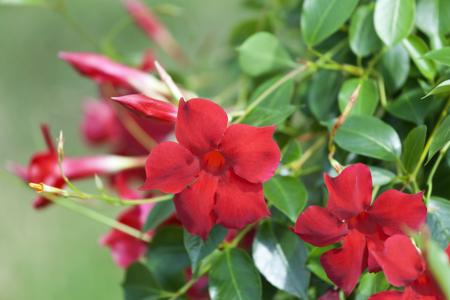





 In the past few years, the popularity of the Mandevilla plant for gardens has risen immensely. This is mainly because of its beautiful showy flowers and the climbing vines. It belongs to the genus of tropical flowering plants and is native to Central and South America. It blooms twice in a year - during early summer and early fall. Its ornamental flowers are found in a large variety of attractive shades of red, pink, white and yellow.How to Take Care of Mandevilla Plant?Even though you do not have to work very hard for the care and maintenance of Mandevilla plants, a few measures should be taken to keep the plant healthy. These are mentioned as follows.
In the past few years, the popularity of the Mandevilla plant for gardens has risen immensely. This is mainly because of its beautiful showy flowers and the climbing vines. It belongs to the genus of tropical flowering plants and is native to Central and South America. It blooms twice in a year - during early summer and early fall. Its ornamental flowers are found in a large variety of attractive shades of red, pink, white and yellow.How to Take Care of Mandevilla Plant?Even though you do not have to work very hard for the care and maintenance of Mandevilla plants, a few measures should be taken to keep the plant healthy. These are mentioned as follows. PreparationWhile planting Mandevilla in your garden, you have to take care of its soil, temperature, and light requirements. It grows well in warm weather conditions and can tolerate the temperature range of 70 to 85 degrees. Select a partially shaded location in your garden for this flowering plant to ensure sufficient exposure to bright light for its healthy growth. The ideal soil for Mandevilla is a rich potting mix that consists of one part of sand, one part humus, and one part of potting soil. This mix is suitable as it provides adequate soil drainage. In case, you want to grow it in a container, select a pot that has a hole at the bottom and a trellis to support the vine.PlantingVine root cutting of Mandevilla should be planted during the spring season after digging a deep hole of approximately 5 inches into the freshly prepared soil. Cover up the hole with soil and water it properly. If you have planned to plant more than one cutting, then keep a gap of 3 feet in between them as it requires a lot of space to grow.WateringSoon after planting, you have to water the plant. Continue to give water to it once a week to keep the soil moist, as dry soil can have an adverse effect on the plant health at this stage. Once the plant roots into the soil, water it three times in a week in spring, summer, and fall seasons. Slowly water the plants early in the morning and let the soil get wet thoroughly. Excessive watering should be strictly avoided as it can lead to rotting of the roots. Keep enough time gap in between two watering sessions for the same reason.Application of FertilizerThis plant requires fertilizer rich in phosphorus. Therefore, add 10-20-10 NPK fertilizer to the soil after every two weeks. Make sure that you water the plant before and after application of fertilizer as it helps in better absorption of the nutrients into the soil. When you apply the fertilizer, take care that it does not come in direct contact with any part of the plant as it can damage its roots.Pruning and RepottingPruning involves removal of all the dead, damaged, and diseased parts of the plant. This will also reduce the chances of attack by fungus. Shortening of the long vines will also improve the visual appeal of the plant at the time of blooming. Repotting is a must after a gap of two to three years. This is because the fresh soil will rejuvenate the plant and promote its growth. First of all, remove all the soil from the roots of the vine. This should be done very carefully or else the root may suffer damage. Select a container whose diameter is a few inches more than the size of the present container. Fill it up with one part each of potting soil, sand, and moss; and place the plant into it. The best time for repotting is late winter.How to Take Care of Mandevillas During WintersSpecial winter care is a must for a Mandevilla plant as it is highly sensitive towards temperature and is not frost tolerant. It cannot survive in a cold climate where night temperature is below 45 degrees. So, you have to bring it indoors as the outdoor temperature goes below 50 degrees Fahrenheit. Before you do so, check the leaves, roots, stems, and foliage carefully for signs of pest infestation. If you find any insects or eggs, then treat the plant with insecticides. Next, you have to gently pull out the plant from the soil and place it in a separate container which is filled up with peat moss, sand, and potting soil. When it is kept indoors, it should receive six hours of indirect sunlight. You can protect it from cold winter temperature by placing it close to the heater. Since it is in dormant state in the winters, you need not water it more than once in a week. Watering is done just to prevent the soil from drying out completely. At this time, no fertilizer should be added to the soil because the plant does not have the ability to absorb the nutrients from the soil. You can take them back into the garden in spring when there is no chance of frost anymore.As you can see, the Mandevilla vine does not require much maintenance except for the winter months. The main reason why it can grow with minimum care is that it does not get infested by pests easily. If you live in an area where the night temperatures during winters do not fall below 50 degrees, then you do not have to transfer the plants indoor, and they can be left outdoors throughout the year.
PreparationWhile planting Mandevilla in your garden, you have to take care of its soil, temperature, and light requirements. It grows well in warm weather conditions and can tolerate the temperature range of 70 to 85 degrees. Select a partially shaded location in your garden for this flowering plant to ensure sufficient exposure to bright light for its healthy growth. The ideal soil for Mandevilla is a rich potting mix that consists of one part of sand, one part humus, and one part of potting soil. This mix is suitable as it provides adequate soil drainage. In case, you want to grow it in a container, select a pot that has a hole at the bottom and a trellis to support the vine.PlantingVine root cutting of Mandevilla should be planted during the spring season after digging a deep hole of approximately 5 inches into the freshly prepared soil. Cover up the hole with soil and water it properly. If you have planned to plant more than one cutting, then keep a gap of 3 feet in between them as it requires a lot of space to grow.WateringSoon after planting, you have to water the plant. Continue to give water to it once a week to keep the soil moist, as dry soil can have an adverse effect on the plant health at this stage. Once the plant roots into the soil, water it three times in a week in spring, summer, and fall seasons. Slowly water the plants early in the morning and let the soil get wet thoroughly. Excessive watering should be strictly avoided as it can lead to rotting of the roots. Keep enough time gap in between two watering sessions for the same reason.Application of FertilizerThis plant requires fertilizer rich in phosphorus. Therefore, add 10-20-10 NPK fertilizer to the soil after every two weeks. Make sure that you water the plant before and after application of fertilizer as it helps in better absorption of the nutrients into the soil. When you apply the fertilizer, take care that it does not come in direct contact with any part of the plant as it can damage its roots.Pruning and RepottingPruning involves removal of all the dead, damaged, and diseased parts of the plant. This will also reduce the chances of attack by fungus. Shortening of the long vines will also improve the visual appeal of the plant at the time of blooming. Repotting is a must after a gap of two to three years. This is because the fresh soil will rejuvenate the plant and promote its growth. First of all, remove all the soil from the roots of the vine. This should be done very carefully or else the root may suffer damage. Select a container whose diameter is a few inches more than the size of the present container. Fill it up with one part each of potting soil, sand, and moss; and place the plant into it. The best time for repotting is late winter.How to Take Care of Mandevillas During WintersSpecial winter care is a must for a Mandevilla plant as it is highly sensitive towards temperature and is not frost tolerant. It cannot survive in a cold climate where night temperature is below 45 degrees. So, you have to bring it indoors as the outdoor temperature goes below 50 degrees Fahrenheit. Before you do so, check the leaves, roots, stems, and foliage carefully for signs of pest infestation. If you find any insects or eggs, then treat the plant with insecticides. Next, you have to gently pull out the plant from the soil and place it in a separate container which is filled up with peat moss, sand, and potting soil. When it is kept indoors, it should receive six hours of indirect sunlight. You can protect it from cold winter temperature by placing it close to the heater. Since it is in dormant state in the winters, you need not water it more than once in a week. Watering is done just to prevent the soil from drying out completely. At this time, no fertilizer should be added to the soil because the plant does not have the ability to absorb the nutrients from the soil. You can take them back into the garden in spring when there is no chance of frost anymore.As you can see, the Mandevilla vine does not require much maintenance except for the winter months. The main reason why it can grow with minimum care is that it does not get infested by pests easily. If you live in an area where the night temperatures during winters do not fall below 50 degrees, then you do not have to transfer the plants indoor, and they can be left outdoors throughout the year.
Copyright © www.100flowers.win Botanic Garden All Rights Reserved